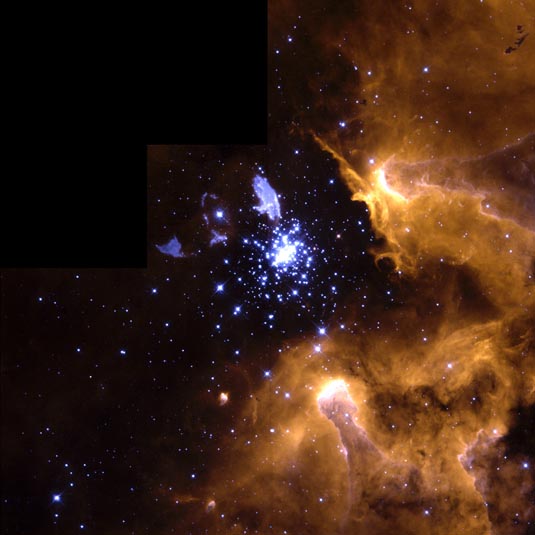
Description: Star-formation nebula, star cluster
Position (J2000): RA 11h 15m 9s.10 Dec. -61° 16' 17"
Constellation: Carina
Exposure Date(s): March 5, 1999
Instrument: WFPC2
Image Credit: NASA, Wolfgang Brandner (JPL/IPAC), Eva K. Grebel (Univ. Washington), You-Hua Chu (Univ. Illinois)
Release Date: June 1, 1999
Other images: S9920 S9946 S0734 S1004 S1005 S1022
ABOUT THIS IMAGE:
In this stunning picture of the giant galactic nebula NGC 3603, the crisp resolution of NASA's Hubble Space Telescope captures various stages of the life cycle of stars in one single view.
To the upper right of center is the evolved blue supergiant called Sher 25. The star has a unique circumstellar ring of glowing gas that is a galactic twin to the famous ring around the supernova 1987A. The grayish-bluish color of the ring and the bipolar outflows (blobs to the upper right and lower left of the star) indicates the presence of processed (chemically enriched) material.
Near the center of the view is a so-called starburst cluster dominated by young, hot Wolf-Rayet stars and early O-type stars. A torrent of ionizing radiation and fast stellar winds from these massive stars has blown a large cavity around the cluster.
The most spectacular evidence for the interaction of ionizing radiation with cold molecular-hydrogen cloud material are the giant gaseous pillars to the right and lower left of the cluster. These pillars are sculptured by the same physical processes as the famous pillars Hubble photographed in the M16 Eagle Nebula.
Dark clouds at the upper right are so-called Bok globules, which are probably in an earlier stage of star formation.
To the lower left of the cluster are two compact, tadpole-shaped emission nebulae. Similar structures were found by Hubble in Orion, and have been interpreted as gas and dust evaporation from possibly protoplanetary disks (proplyds). The "proplyds" in NGC 3603 are 5 to 10 times larger in size and correspondingly also more massive.
This single view nicely illustrates the entire stellar life cycle of stars, starting with the Bok globules and giant gaseous pillars, followed by circumstellar disks, and progressing to evolved massive stars in the young starburst cluster. The blue supergiant with its ring and bipolar outflow marks the end of the life cycle.
The color difference between the supergiant's bipolar outflow and the diffuse interstellar medium in the giant nebula dramatically visualizes the enrichment in heavy elements due to synthesis of heavier elements within stars.
This true-color picture was taken on March 5, 1999 with the Wide Field Planetary Camera 2